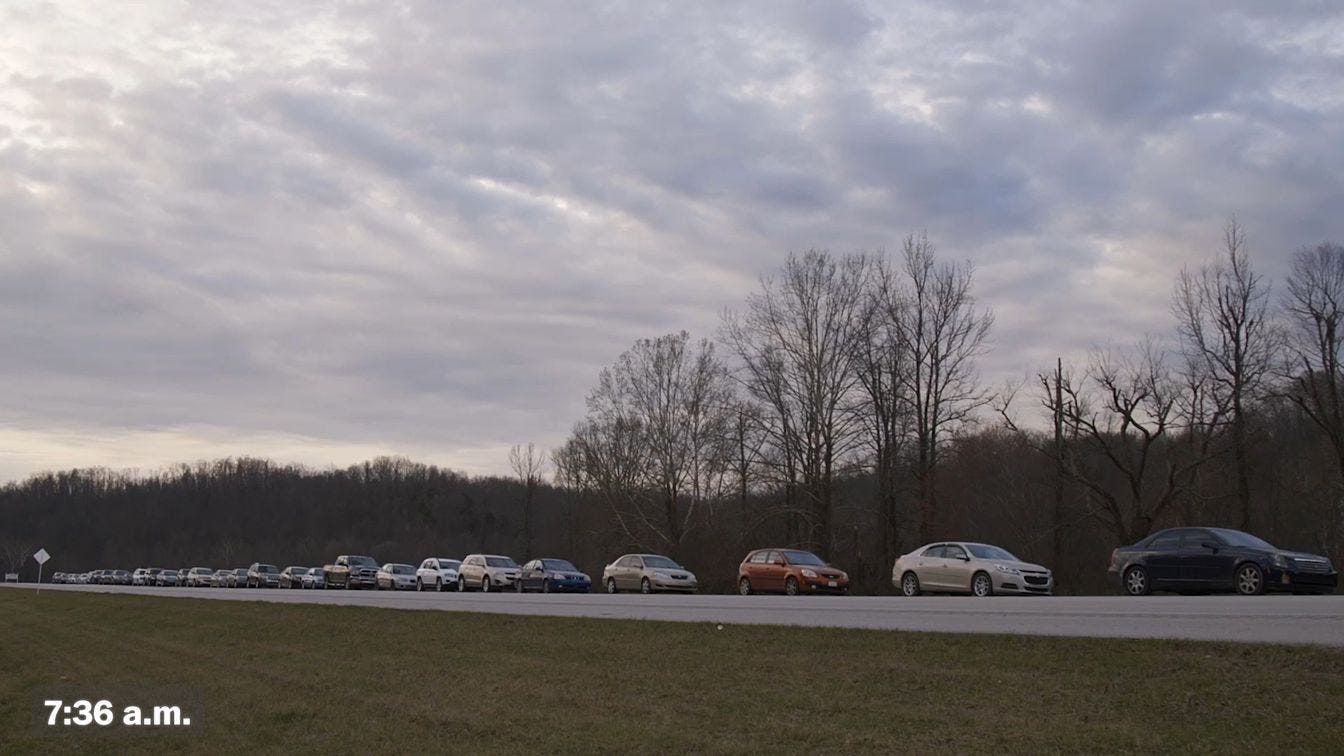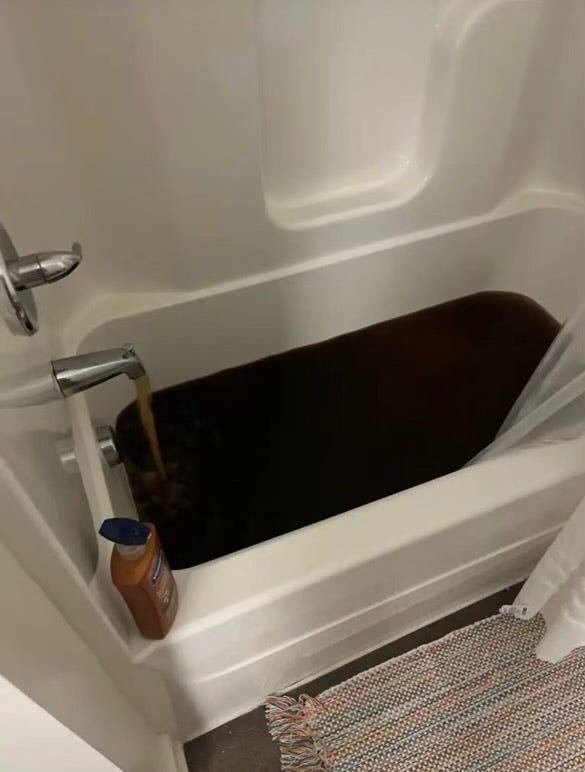This series by Eli Navarro will examine the persistence of American poverty — why millions of people struggle to obtain the basics in the world’s richest country.
Lines for Food. No Running Water. Full-Time and Homeless.
A mile long line of cars and trucks starts forming around 4 A.M. Those in line have come out to receive food and medicine from the Hazel Green Food Project, a food bank in eastern Kentucky. “I’m a senior citizen doing without food,” says Kernie Roark, who shows up regularly.

Two states away in Jackson, Mississippi, an ongoing water crisis has upended daily life. David McGowan frequently drives to the local church where bottled water is distributed. When his cars stopped running over Christmas, he relied on buckets he had filled before the water line shut off. “This is no way to live,” McGowan laments.
Almost 2,000 miles away in Los Angeles, Nereida locks up at the optometrist’s office where she works full-time. Even with a job, Nereida has struggled to secure long-term housing. “There’s been several times where I just slept in my car,” she said.
Lines for food. No running water. Full-time and homeless. Millions of people in America live with scarce access to life’s necessities. We routinely ignore or justify their reality, a negligence that is particularly cruel since food for Kernie, water for David, and housing for Nereida are all within reach.
Poverty and the Basics of Life
Nearly 40 million Americans live in poverty according to the federal government. That includes every person in a household that falls below the income threshold known as the poverty line. Here’s the 2021 table of poverty thresholds:
Let’s consider how much $14,097, the poverty threshold for an individual, gets you in my hometown of Miami. The yearly rent to split a median-price two-bedroom apartment with a roommate is $12,600. That leaves around $1,500 for everything else in your life. Even if you ate two servings of Walmart white rice every day for breakfast, lunch, and dinner, less than $1,250 remains for transportation, utilities, clothing, and other expenses.
No type of budgeting can provide a decent standard of living with this little. Yet nearly 40 million people in this country face these constraints — not including millions more above the poverty line who are not much better off.
It’s possible to find an apartment below median rent or apply for SNAP, formerly known as Food Stamps, to cut down on expenses. But a closer look at food, water, and shelter, the basic elements of human life, shows government policies are absent or insufficient.
Food
34 million people were food insecure at some point in 2021, meaning they had uncertain or limited access to a healthy, safe diet. Food insecurity can mean struggling to find your next meal or skipping meals altogether.
Teresa lives in Colorado Springs. She eats “about a meal a day.” For years a disability has left her unable to work. Teresa can’t always eat when she feels hungry.
Raynah resides in rural southern Oregon with her son. At the onset of the 2020 pandemic, her son was underweight and in danger of stunted physical and cognitive growth. The nearest food bank receives too much demand to reliably help Raynah feed her son.
Jake and Trish both work full time on the Wind River Reservation in Wyoming where they live. Yet Jake, Trish, and their children still grapple with food insecurity. “You have to figure out how to make the meals stretch,” explains Trish. Sometimes, Jake and Trish turn to their local food pantry for support.
Teresa’s experience shows that those unable to work are vulnerable to food insecurity. Raynah’s case demonstrates how food insecurity harms families with children. Jake and Trish’s story proves that food insecurity can persist even in households with two parents employed full-time.
Teresa, Raynah, Trish and Jake, and the tens of millions of people that face food insecurity have two options when they can’t afford food: SNAP and food banks. Both alleviate food insecurity while leaving gaps that ensure the problem continues.
The Supplemental Nutrition Assistance Program (SNAP), previously known as Food Stamps, provides participants with a payment card that can be used to purchase food. SNAP boasts a tremendous track record in tackling food insecurity, but it fails to reach everybody that’s eligible. Even those whom SNAP reaches don’t always get enough. Both Teresa and Raynah typically receive a little over $20 a month in SNAP benefits, a minuscule amount that can’t pull them out of food insecurity.
Food banks help reduce food insecurity, but they can only do so much. Across the country, food banks face long lines and “immense strain” in trying to meet demand. As those who run them will admit, food banks’ monumental efforts can’t cover the gap left by SNAP.
Food insecurity envelops the lives of tens of millions in the United States. Though programs and institutions exist to mitigate the issue, they don’t eliminate it.
Water
2.2 million Americans don’t have running water or working toilets in their homes. Millions more pay an excessive portion of their incomes for water services.
In Lowndes County, Alabama, at least 40% of homes have “inadequate or no sewage systems.” To adapt, residents jerry-rig PVC pipes that transport waste to holes in the ground outside, creating a perfect breeding ground for hookworm, a parasite that hatches from human waste and burrows into people’s feet. Hookworm disease is endemic in countries like Ecuador, Mozambique, and India. A 2017 study found that about a third of Lowndes County residents are infected as well.

Hookworm disease is endemic in countries like Ecuador, Mozambique, and India. A 2017 study found that about a third of Lowndes County residents are infected as well.
Jackson, Mississippi catapulted into national headlines last summer when its water system went out for days. But the miserable history of water in Jackson predates national attention. Between May 2020 and October 2022, the city of Jackson issued 320 boil water notices. In the midst of this crisis, residents reported that their water bills doubled or even quadrupled.

Lowndes County has about 10,000 residents while Jackson has about 150,000. Both are majority Black with poverty rates far above the national average. Lowndes County environmental activist Catherine Coleman Flowers believes that the waste water problem “is happening because the county is majority Black. We’re rural… so people may think that we’re not smart. But we’re smart enough to know when we’re getting screwed.” Maisie Brown, born and raised in Jackson, holds analogous views: “I don’t think we realize how deeply ingrained racism is in all of our structures and systems, including infrastructure.”
Disruptions to water supplies make normal life impossible. “You cannot function right without your water,” observes Kimberly Owens of Jackson.
Shelter
In 2020, around a quarter of American renters reported spending more than half of their income on housing, far above the 30% threshold considered rent burdened. As housing costs increase and income stagnates, people below and around the poverty line are struggling to find places to live, and if they do, they sacrifice on other expenses like food and health.
Housing squeezes every last dollar out of America’s poor, even those with full-time jobs. In no state in the country can a full-time worker making local minimum wage afford a one-bedroom apartment at fair market rent. A year of full-time work at federal minimum wage gets you above the poverty line, so the nearly 40 million people below the poverty line especially suffer.

Matthew from Minnesota has to choose between rent and food when his disability benefits come in. He’ll usually opt for rent, since The Salvation Army can cover food. Matthew’s situation illustrates how the housing crisis can increase demand at food banks, further stretching resources meant to tackle food insecurity.
When housing costs are too high, temporary or chronic homelessness follows. On any given night, between 500,000 and 600,000 people experience homelessness in the United States.
Defining and counting people experiencing homelessness is complicated. It’s uncertain if Nereida, the optometrist office worker, gets counted. Regardless, studies consistently show that like Nereida, a large portion of those without a home work in some capacity. One paper from the University of Chicago found that over 40% of people had some earnings in the year they were counted as homeless — undercutting the common assumption that homelessness results from an unwillingness to work.

Homelessness fractures the lives of those who can’t and shouldn’t be expected to fend for themselves, our nation’s youth. Public schools identified over a million students experiencing homelessness at some point in the 2020-2021 school year. Youth homelessness leads to illness, injury, mental health problems, and substance abuse.
Some policies target housing affordability and homelessness, but authorities often prioritize criminalization. In his report on a visit to the United States in 2017, the United Nations Special Rapporteur on extreme poverty and human rights drew attention to the “myriad … [offenses]” created to target people experiencing homelessness, and how they play into “stigma of a criminal conviction that in turn virtually prevents subsequent employment and access to most housing.”
Law enforcement fails to address the causes of homelessness while making it more difficult for unhoused people to find jobs and accommodations.
“The Total, Direct, and Immediate Abolition of Poverty”
Poverty should not exist in the richest country on Earth. Scarcity does not cause poverty in America; there is no law of nature that demands millions go without enough. The line for the food bank in eastern Kentucky, the water crisis in Jackson, homelessness in Los Angeles — these are the results of choices we’ve made. Other paths exist: realities where everyone can have food, water, and a home. An America where we heed Dr. Martin Luther King. Jr’s call to “civilize ourselves by the total, direct, and immediate abolition of poverty.”
The first steps in poverty reduction have been charted elsewhere, from guaranteed housing in Finland to universal basic income trials in Kenya. For the steps not yet taken anywhere, there’s no reason, as the United States of America, we can’t be the first.
Eli Navarro writes on economic policy and is a recent graduate of Stanford University





Excellent, Eli! You've shed light on the unfortunate reality of inequality and racism in the world's wealthiest and most influential nation. It would be great if you could continue to explore this topic through a series of articles that suggest potential solutions to this pressing issue in the United States, a country that once symbolized hope and opportunity for all.
Great read! Excellent summary of inequality in the US, especially relevant for those still proclaiming the virtues of American capitalism.